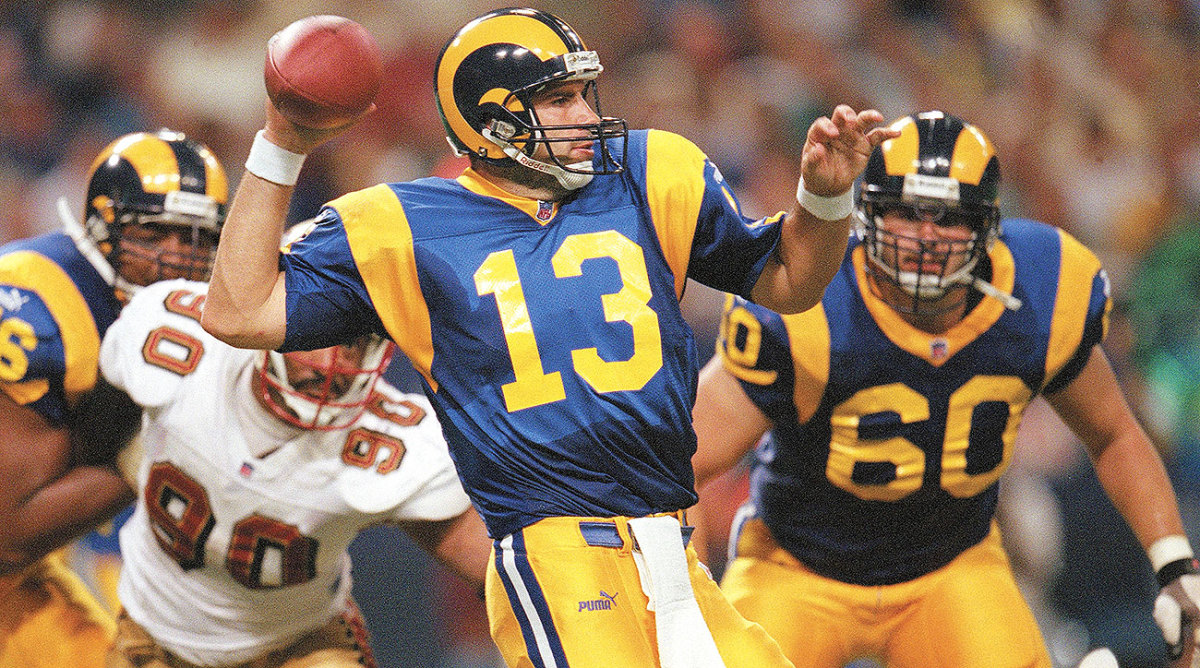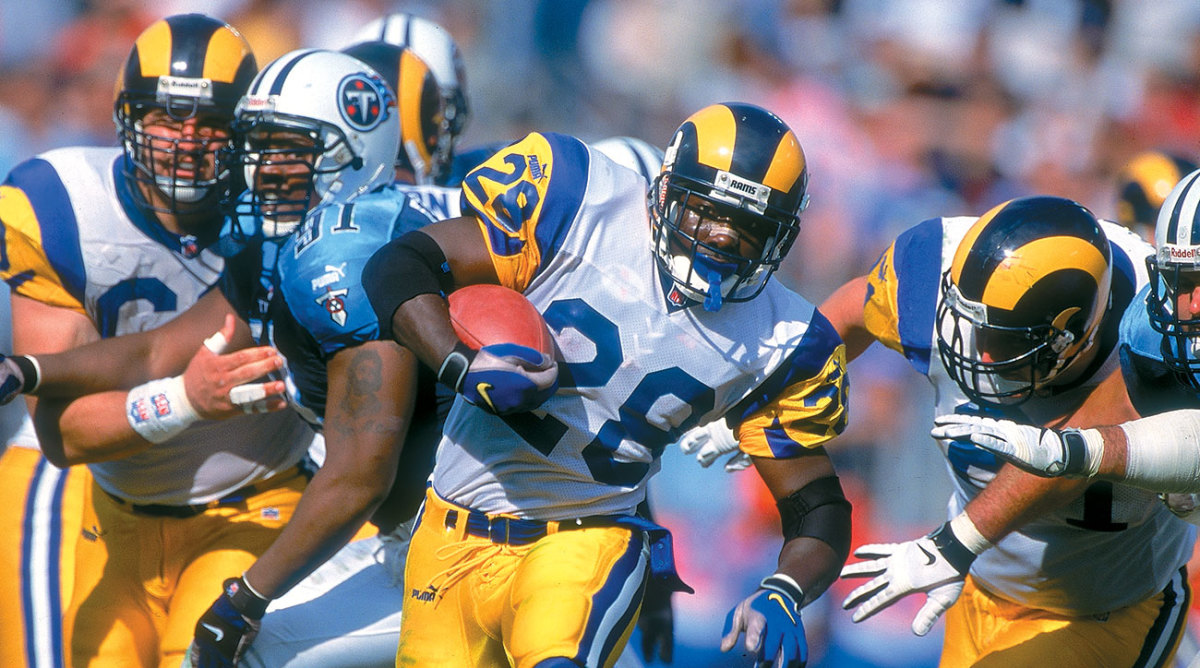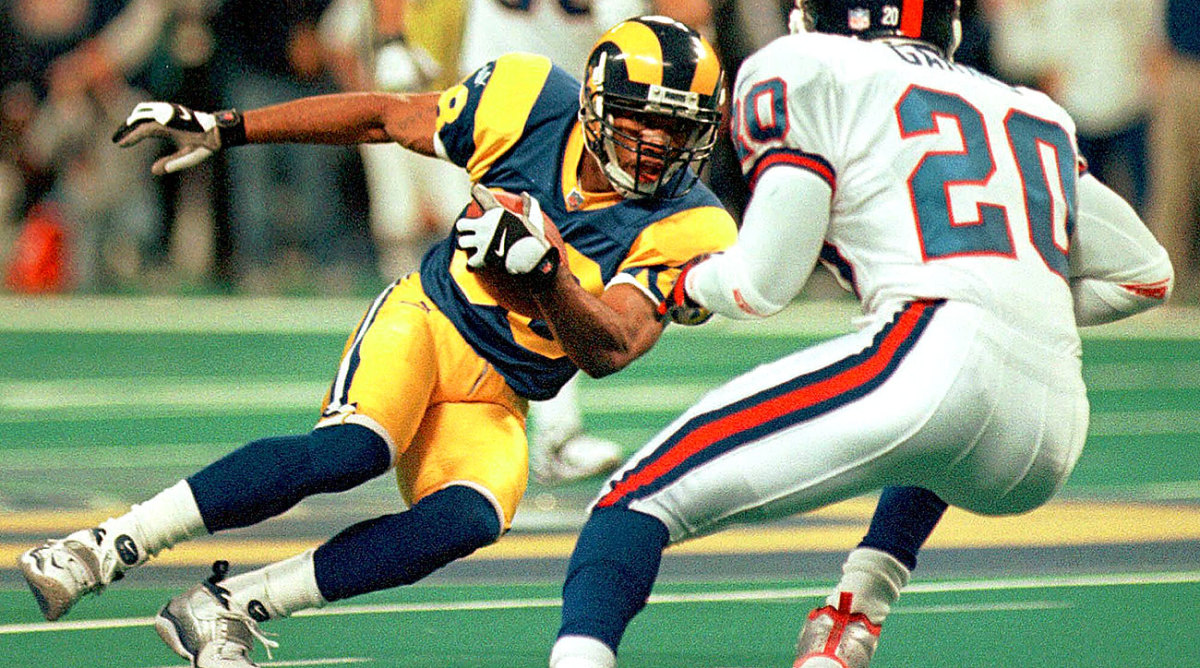How Mike Martz and The Greatest Show on Turf kicked off an NFL revolution

Sometimes a catalyzing event occurs, one so extreme that it disrupts the natural order, compelling a species to change. Those are the anomalies, the aberrations, the hurricanes and tornados, extreme mutations, phenomena that upend the system. In those instances the evolution is rapid, sudden and without warning. In biology, they call it the punctuated equilibrium theory. In football, we called it the Greatest Show on Turf.
Dick Vermeil got his first NFL coaching job in 1969, hired by Marv Levy to be a special teams coach with the Los Angeles Rams. Roman Gabriel, the Rams quarterback that season, threw for 2,549 yards and completed 54.4% of his passes—good enough to be named NFL MVP. Thirty seasons later Vermeil returned to the Rams, this time to be the head coach of a very different team, in a new city, with a very different MVP under center.
“I saw the evolution,” Vermeil says. “It was slow. Every year teams threw a little more, scoring went up a little more. When you have 32 teams, they don’t all transcend to a new philosophy at the same time.”
But the 1999 Rams transcended. For decades the NFL had been slowly inching towards putting a greater emphasis on the passing game, with incremental changes coming every year. But then along came the Rams. And they blew the whole damn thing up.
Predicting every NFL team's 2017 record
In the three decades between 1969 and ’98 the average quarterback rating in the NFL rose 6.7 points, passing totals increased 27.5 yards per game and completion percentage grew 4.0%. In the seasons since 1999, when those Rams upended and redefined the NFL’s status quo, QB rating has risen 11.0 points, passing output 36.5 yards, and completion percentage 6.4%—nearly double the increase, in roughly half the time.
The Rams were the tornado, the anomaly that compelled a sudden and rapid evolution of football. They were the catalyzing event that disrupted the equipoise of the NFL, a punctuated equilibrium of pigskin.
“At the time, we knew we were doing something special,” Rams receiver Torry Holt says. “But we didn’t know we were revolutionizing the game.”
Last season, the Atlanta Falcons scored 540 offensive points, which tied the Rams for seventh most in NFL history. The Falcons’ offense, led by Kyle Shanahan, was as close to a direct descendent of the 1999 St. Louis team as we’ve seen. Aaron Rodgers leading the NFL in fantasy points? Thank the Rams. Record books that have been razed and rewritten? Blame the Rams. Running backs who now need to run routes and catch passes as part of their job description; tight ends who now are no longer glorified blockers, but athletic freaks and dynamic pass catchers; receivers who now are no longer just big and tall and asked to run one route, but small and shifty and running every route in the book? Rams, Rams, Rams.
“The more and more I sit back and think about it,” Holt says, “I think, damn maybe we were ahead of our time.”
But, as is the case with all innovators, the Rams were not without their detractors. Like the mutants in X-Men, they were seen as unnatural, abnormal, freaks going against the world’s accepted norms. During the 1999 season, Mike Silver summed up the sentiment of the time by writing, in a Sports Illustrated magazine story, that the St. Louis offense “seems to violate all the tenets of traditional football.” Both the players and the coaches could hear the cries from stodgy commentators who felt they were desecrating the game of football.
“You cannot imagine how blistering the critics were, it was like we defamed the pope” offensive coordinator Mike Martz says. “Now it’s celebrated.”
Martz could hear the Rams own fans screaming from the stands, imploring him to run the ball more. Now the Patriots are hailed as geniuses when Tom Brady throws 20 consecutive passes. Now the Saints are lauded for their diverse offensive scheme. Now coordinators study the ’99 Rams play-calling, their route concepts, their system. Now the ’99 Rams are emulated.
“The more and more I sit back and think about it,” Holt says, “I think, damn maybe we were ahead of our time.”
• SI VAULT: Kurt Warner and the Rams beat the Titans in the greatest Super Bowl ever
As a high schooler in the late 1960s, Martz frequently sat in the bleachers at San Diego Stadium, where he would watch, spellbound, as Don Coryell’s Aztecs dismantled opponent after opponent with a high-powered offensive attack that was nearly impossible to stop. What struck Martz was how different it was.
Martz remembers marveling at how several of Coryell’s opponents would agree to play with a running clock in the second half of games, to spare themselves more embarrassment. He yearned to play for Coryell’s teams, but four years later he found himself suiting up against them as a tight end for Fresno State. Yet, as his playing career morphed into a coaching career, he remained transfixed by Coryell’s vision for what football could be.
“It all began with Don, to be honest with you,” Martz says. “We just expanded upon what Don did.”
The so-called “Air Coryell” system is a vertical offensive attack, one that eschewed the traditional pro set formation (one running back, one fullback, one tight end, two wide receivers) by putting multiple receivers on the field at once and spreading them out wide. It emphasized the passing game, forced defenses to defend the entire field, and, above all else, was exciting as hell to watch.
Re-grading the 2014 NFL draft, three years later
Coryell later went on to coach the Chargers, his coaching tree branching off to include Ernie Zampese, Joe Gibbs, Norv Turner, Al Saunders, and eventually Martz, his most renegade disciple. Martz studied Gibbs, coached with Zampese and with Saunders, and served under Turner, borrowing from each to eventually form his own version of the offense.
But while the seed had been planted decades earlier, the breakthrough moment came with a joke cracked in a cramped meeting room in Ashburn, Va., circa 1998. Turner, then the Redskins head coach, sat beside Martz, his offensive coordinator, dissecting film and debating ways to make their football team more competitive. They realized that their offense typically faced about eight third downs a game, yet they prepared dozens of designed “third down plays” every week.
Turner remarked that the third-down plays Martz was drawing up were some of his favorites, but he lamented that they were being wasted. He quipped that maybe they should run their third-down plays on first down, to pass when NFL dogma dictated that coaches should run.
“We both just laughed,” Martz says. “Then the next year I leave for the Rams and we started making it up as we went.”
Martz built upon the philosophy, expanded it, tweaked it, evolved it— making it fit his players and his vision. Never before had the system approached the level of success that Vermeil, Martz and the Rams achieved with it, largely because never before had the system seen the level or breadth of talent that the Rams possessed.
“Let’s be honest,” Warner says, “we had a collection of talent that was ridiculous.”
It is a misnomer that Vermeil had to be dragged to compliance to allow Martz to install his offense, that he was a begrudging witness to the revolution. Vermeil took over the Rams in 1997 and in his first two seasons won nine games and lost 23. But amid the losses, he had been slowly restocking his offensive arsenal. When he took inventory of his vast menagerie of talent in the offseason prior to the ’99 season, he realized he could no longer be a ground-and-pound coach.
The best coaches adapt to their roster. So he hired Martz and set him free.
“When I brought [Martz] here I promised him I’d let him do it,” Vermeil says. “I told him: this is your baby. All I’ll do is support you.”
While the 1999 team shocked the football world with their sudden arrival—a nine-win increase over the previous season, a record-setting offense and a Super Bowl win—Vermeil had really been assembling the pieces to make the system hum for a while. For his first move as head coach, Vermeil traded four picks to acquire the New York Jets first overall pick in the 1997 draft, widely considered a weak draft. Vermeil used the selection on Orlando Pace, who went on to become one of the best left tackles in league history and the unsung fulcrum of the Rams machine.
“It took a couple of years,” Vermeil says, “but the whole process eventually came to fruition.”

The process started by retaining Isaac Bruce, a second round pick for the Rams in 1994. It involved the prescient and serendipitous signing of Kurt Warner in ’98, a grocer at the local Hy-Vee in Cedar Falls, Iowa just four years prior, as third-string quarterback. That preceded the unheralded drafting of speedy Az-Zahir Hakim in the fourth round of the ’98 draft, and the free agent pick up of crafty veteran Ricky Proehl that same year. It was officially set in motion with the heist of Marshall Faulk, in a trade from the Colts as a result of a contract dispute; and it culminated with the selection of Torry Holt with the sixth pick in ‘99.
“Let’s be honest,” Warner says, “we had a collection of talent that was ridiculous.”
It was also a collection of talent that all possessed a rare quality, an ineffable quality, a borderline cliché quality, that allowed the Coryell system to operate at a level of efficiency and efficacy that had never before been seen: high football IQ. It enabled Martz, a football savant and audacious innovator, to have full confidence in the system, allowing it to reach its full potential. Martz is the first to admit that coaches always look smarter when they have great players at their disposal.
“Once we realized how in depth and smart [Martz] was,” Holt says, “and he realized that we were equally the same, that helped with the creativity of the play calling. I think some coordinators have those kind of plays in mind, but it’s another thing to have the confidence in the players to call those plays. I think that’s what allowed us to be different.”
In that era of the NFL, defense dominated football. The “zone dog” blitz concept, popularized by Buddy Ryan, had been regularly giving offenses fits, and in an attempt to combat it, teams were forced to keep their running backs and tight ends in to block, oftentimes sending only two receivers out on pass patterns. As a result, offenses had become entirely predictable.
Martz did away with that. Completely. He’d empty his backfield, split Faulk out wide with four receivers, daring the defense to blitz. It was also the perfect system for Faulk— a gifted pass catcher, and skilled route runner— who racked up 1,048 receiving yards that year, the most for a running back in NFL history.
“It was the antithesis at the time of the way the game was being played,” Martz says. “We just said, if you can cover everybody God bless you, but I bet you can’t.”
The Rams passed a whole lot, and by using the pass to set up the run, Martz reversed the common thinking at the time. But contrary to how history remembers them, the Rams were more than happy to run the ball once they attained a comfortable lead. Faulk finished the season with 1,381 yards, a career high and good for fifth in the league. In the second half of games the Rams had the sixth-largest proportion of rush plays in the NFL, and they had the largest ratio of runs in the fourth quarter.
“I like running the football,” Martz says, “but I like running the football well.”

The Rams did end up using their third-down plays on first down, just like Turner had joked, passing on a league-leading 59% of such downs. And those plays proved to be wildly successful, netting them 7.6 yards per attempt—11% more than the rest of the NFL averaged on attempts that year on all downs. They scored touchdowns on 7.4% of those first down passes, nearly twice the league average across all pass attempts.
The system proved to be an ideal fit for Warner, who took over as starter after Trent Green was injured in the team’s third preseason game. “I came from arena football,” Warner says, “so I had a different mentality than a lot of people. I expected to score every time I touched the ball.”
Martz also, in football parlance, did a lot of “formationing” and personnel changes— something he says he “kind of stole” from studying Gibbs’ Redskins squads. That means that the Rams would often run the same play out of several different formations, with a variety of personnel on the field. They purposefully toyed with defenses, sending players in motion, sometimes changing their formation three times before the snap.
“Half the time defenses were so misaligned and had people in the wrong places, they couldn’t get lined up at the snap of the ball,” Martz says. “They just hadn’t seen any of that before.”
NFL draft trade retrospective: A team-by-team look at the best moves of the last decade
The system was ideal for the St. Louis receivers— which had four dynamic and well-rounded pass-catchers, able to run every route in the route tree, utilize double moves, and spread the field in a way that had also never before been seen. Their playbook was filled with 30-yard throws—dig routes that broke 25 yards down the field with the quarterback taking a seven-step drop. (Hence why Pace, the left tackle, and the entire offensive line was so imperative to the offense’s success, sometimes needing to bide the quarterback three or four seconds in the pocket for the play to develop.)
“That was unheard of,” Holt says, repeating a common refrain. “The league had never seen anything like that before.”
Or as Bruce puts it: “It was like when Muhammad Ali first came on the scene.”
The NFL simply didn’t know how to react. Holt remembers watching defenders cycle through different pairs of cleats pre-game, in a futile attempt to find the right footing that might allow them to stymie the Rams attack. Bruce remembers receivers on other teams longing to play in St. Louis, asking him to put in a good word. Warner remembers opponents approaching him and remarking that their offense resembled a video game, both unfair and unstoppable.
But once the NFL saw what could be accomplished—two Super Bowl trips in three years with an offensive salvo of excitement and a subsequent surge in fan interest—they were hooked. After the Rams ended up narrowly losing to the Patriots in the 2001 Super Bowl—after a three-year stretch in which they scored 1,659 points, an NFL record—the league began making changes that favored offenses.
They adjusted rules (and made it a point of emphasis to strictly enforce existing ones) that provided receivers with more space and freedom at the line of scrimmage, more safety across the middle of the field, and more leeway in pass interference calls. This coincided with separate rule changes that made the quarterback a walking “Do Not Touch” sign. It was if the league was setting up artificial parameters so that other teams could replicate what the Rams achieved.
“I think the National Football League fell in love with that part of the game and wanted to see more of it because of the reaction of the fans,” Holt says. “They took what we were doing and tried to transition the game and make things easier for offenses.”

In 1999, Warner’s 109.2 passer rating ranked as the second-best all time. Now, it has fallen to 13th. His 65.1% competition percentage was the third best mark in league history. Now, it’s fallen all the way to 74th, surpassed by three other seasons by Warner himself. At the time, the Rams 32.9 points per game was the second highest total ever. Now, it ranks ninth. Actually, of the top 20 highest scoring teams in NFL history, 17 are either teams that came after the Rams three-year run or those Rams teams themselves.
“There’s times we do say, oh man what would we do if we were in this league,” Warner admits. “But at the same time we take great pride in the fact that we were able to accomplish all we did before those rules were made.”
Vermeil mentions how that offense will “soon have five Hall of Fame” players, projecting the imminent inductions of Bruce and Holt to join Warner, Faulk and Pace. Many have surmised that the two receivers have only been snubbed by the Hall for this long because of how good those Rams teams were, claiming that their success was merely a result of the conditions on the team they played for.
That idea rankles Martz. He points out that the game is about, has always been about, players. Not systems, not coaches. And for a few years there, he had a collection of offensive talent that was rare and fleeting.
“We had a three-year run that I don’t know if anyone will ever be able to duplicate,” Martz says. “I don’t think the league will ever see anything like that again.”
That’s because they were the first. Anything that comes after is merely a facsimile, one that will never be able to match the radical innovation that shocked our systems and changed a sport. No matter how many rule changes are made, no matter how much the NFL tries, there will forever be only one Greatest Show on Turf.
